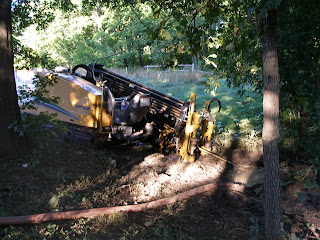A New Paradigm
One of the consequences of learning new things is always having to adjust ones paradigm or point of reference. New information must be put in context. We do not live in a vacuum. Integrating knowledge to action requires energy and sometimes the realizations that come with education are depressing. The world rarely changes just because we discover new thought. Things that are may always have been, just unrecognized by the unseeing eye. Johann Wolfgang von Goethe (1749-1832) said "We see only what we know". I think this is true. Most of us see only what we recognize as trees. Some of us can recognize different tree species. I would like to be able to see trees like some of my compatriots. They can name them; describe their characteristics, uses, and ecological functions. They see the whole tree and its place in the forest literally and ecologically. How can you value something if you do not know its place? The Anishinabe call a well lived and informed life, "Walking in Beauty", but they also attach an obligation to knowing. As people come to know things, they are responsible to act in accordance to the new knowledge. It is what is best for the people and the future. "Coming to Know" and "Walking in Beauty" are poetic concepts of the Dakota people. Their lives were filled with immense detail on every facets of the natural world. Every plant, animal, insect and earth formation had ensoulment, a right to be.
Ultimately, not only did the native people recognize each species, they recognized them as part of their life. When I teach landscape design to property owners, I spend much time teaching them to read the land, listen to the land and observe that it has much more to offer if they take time to assess its resources. Its great capacity to supply unending resources only happens if its natural momentum is encouraged. We can stand in the woods with our hands on our hips, or humbly engage the land and allow it to nurture us.
In Native American Studies, seeing patterns in nature that were recognized by ancient cultures and incorporated into their art, tells a story of their response to issues of that day. I struggle with personal and cultural preferences, but mostly find them irrelevant in good design. A style may appear as we get in a little influence by all our decisions and a style develops over time. Yet, studying diverse sources of knowledge can help keep the decisions true and the principles in front so each situation is assessed for its natural patterns. These patterns in culture, history and nature help define the real issues and opportunities. By studying history I see repeating patterns in human activity. In studying design I see similar patterns and a way to communicate those concepts not easily displayed outside artwork.
Ultimately, not only did the native people recognize each species, they recognized them as part of their life. When I teach landscape design to property owners, I spend much time teaching them to read the land, listen to the land and observe that it has much more to offer if they take time to assess its resources. Its great capacity to supply unending resources only happens if its natural momentum is encouraged. We can stand in the woods with our hands on our hips, or humbly engage the land and allow it to nurture us.
In Native American Studies, seeing patterns in nature that were recognized by ancient cultures and incorporated into their art, tells a story of their response to issues of that day. I struggle with personal and cultural preferences, but mostly find them irrelevant in good design. A style may appear as we get in a little influence by all our decisions and a style develops over time. Yet, studying diverse sources of knowledge can help keep the decisions true and the principles in front so each situation is assessed for its natural patterns. These patterns in culture, history and nature help define the real issues and opportunities. By studying history I see repeating patterns in human activity. In studying design I see similar patterns and a way to communicate those concepts not easily displayed outside artwork.


Comments